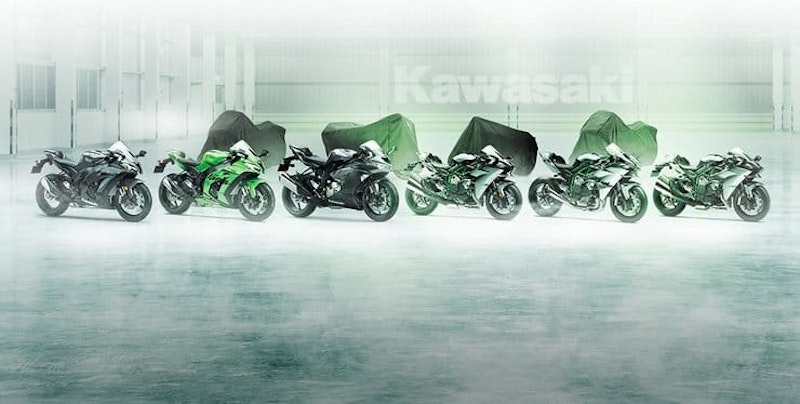BikeSocial’s Bike News Round-up 26/10/18
By Ben Purvis
Motorcycle Journalist
25.10.2018
Need to catch up on what’s been going on in the world of motorcycling over the last week? Here’s your five-minute briefing.
1: Four new Kawasakis coming to EICMA
A countdown timer on Kawasaki’s US website hints that the firm is planning to unveil four new models at the EICMA show in Milan in early November. The firm is using the image you see here to publicise the event, clearly showing four covered-up machines lined up behind the 2019 models that it’s already revealed – the new ZX-6R, updated ZX-10R variants and the more powerful 2019 Ninja H2 models.
So what are the four covered bikes? Well, we know about two of them for certain. One is an updated Versys 1000, which we’ve written about here. And another guaranteed new model is the naked Z400, a derivative of the Ninja 400. Again, we’ve written about the Z400 before.
So what are the other two?
The word from Japan is that one will be a new retro machine to replace the old W800. We’ve been told to expect a water-cooled parallel twin rather than the old W800’s air-cooled motor, but other than that the new W is said to follow all the same retro ideals as its predecessor. And with the likes of Triumph’s latest Bonneville range selling so well, it makes sense for Kawasaki to get back in on that action.
The final bike is believed to be a mildly revised Ninja H2 SX sports tourer. That also makes sense, as the H2 SX is one of the only bikes left in Kawasaki’s range that’s still listed as a ‘2018’ model rather than a ‘2019’ version on the firm’s website. Quite what will be changed on the bike remains a mystery, but we’d bank on electronic suspension, at least on the ‘SE’ model.
2: More info on Arc Vector electric superbike
Another new model that’s set to take a bow at EICMA in November, the Arc Vector is an intriguing electric proposition that plans to introduce a new level of haptic interaction between machine and rider.
The bike – which is likely to be eye-wateringly expensive – is a British-built creation, largely made of carbon fibre, with unconventional front suspension and, of course, electric propulsion. But its main talking point will be the inclusion of a connected, haptic riding jacket and HUD-equipped helmet that between them form the interface between you and the bike.
Mark Truman, Arc founder and CEO, said: “At Arc, we have set out to create an electric motorbike with soul, one which thrills riders every bit as much as a high performance internal combustion bike, and which is more inspiring and desirable than any other two-wheel motorcycle on the planet.
“We’ve taken technologies previously unexplored by bike builders to transform the way we ride. Arc Vector satisfies those of us who are rarely satisfied, who are always looking for a different road, a different view. We understand the need to be different, to be better, and challenge the norm.
“The sensory experience this machine provides, with its haptic amplifiers and HUD helmet, has never been done before. People ask me if this could be distracting, but it is actually designed to be the total opposite. The tech frees you and your senses because the distractions have been removed. It allows you to concentrate on the road and your one-ness with the bike, to just enjoy the moment knowing the bike is looking out for you and the information you need is right in front of you.
“You can set the bike and the haptics to different modes, and my favourite is Euphoric Mode. You can play your music while riding and the Origin jacket will play the music into you. Imagine the bass in nightclub, it can make the hairs on the back of your neck stand up. This is technology we’d seen previously in the entertainment world and improved upon. In total, we’re working with 15 technology partners and suppliers, and they are the best in the business.
“We took a wide-angle view of what mobility in the future could be and using some big ideas and immense agility we have brought it into the present. We are building the Vector for people who are on a journey, and we want people to continue taking those journeys in a future world where the use of internal combustion engines will be restricted.”
3: Harley-Davidson sales continue to slide
Harley-Davidson has been having a rough time recently. Already reeling thanks to a declining US motorcycle market, 2018 has seen it taking body-blows from the USA’s import tariffs on steel and aluminium and the EU’s retaliatory duty penalty on US-made bikes.
To compound the problem, Harley’s plans to move some production abroad, in part to circumvent those tariffs, have come under fire from President Trump, who called for a boycott on the company’s bikes.
The firm’s latest figures show that its US sales are still sliding, down 13.3% in the 3rd quarter of 2018 compared to the same period last year, and 10.2% for the whole year to date. YTD sales are also down in Asia (-5.1%) and Canada (-4.8%). But in Europe and Latin America, the firm has seen increases of 4.7% and 9.3% respectively, helping limit the worldwide sales decline to a drop of only 5.9%.
Despite the dropping sales, Harley’s profits have actually increased, with net income for the third quarter hitting $113,855,000, up from $68,209,000 in the same period in 2017.
The firm’s plans for the future – which you can read about here – show an increased focus on Europe and newfound product diversity that moves the company away from its reliance on the cruiser market.
On the same day it announced its latest financial results, Harley took yet another hit as it revealed a massive worldwide recall of 2017 and 2018 Touring, Trike and CVO Touring models, plus some 2017 Softails. Some 238,300 bikes altogether are affected by a clutch actuator problem that could result in a leak. Harley reckons the recall will cost around $35 million to complete.
4 Honda reveals HRC CBR250RR
Quite why Honda still hasn’t opted to offer the CBR250RR sports bike in Europe, even though it’s been on sale in Asia for a couple of years now, remains a mystery – although rumours of an enlarged 350cc version for our market do crop up every now and then.
But even though we can’t have it, it’s worth taking a look at the new HRC version of the bike that Honda unveiled at the Japanese GP at Motegi.
Painted to look like the CBR1000RR used by Takumi Takahashi in the All-Japan Road Race Championship this year, the CBR250RR isn’t mechanically changed but the new colour scheme is expected to be offered on production models in 2019.
With a revamped Yamaha R3 for 2019 and plans for a Suzuki GSX-R300, and of course Kawasaki’s Ninja 400 already on the market, surely it’s time for Honda to get in on the action with a European version of its twin-cylinder baby CBR…
5: Rex McCandless gets blue plaque honour
Rex McCandless (1915-1992), creator of the legendary ‘featherbed’ frame, has been honoured with the unveiling of a blue plaque at WAC McCandless Engineering Ltd in Belfast on Thursday.
Jeremy McWilliams unveiled the plaque, which marks the engineering achievements of McCandless.
A successful pre-war road racer, McCandless realised that a more rigid frame could allow suspension to work more efficiently, and created the tubular steel design that would become the Norton ‘Featherbed’ at the dawn of the 1950s. It influenced motorcycle design around the world, with similar double-cradle designs becoming the norm for high-performance bikes until the advent of aluminium beam frames decades later.
McCandless would go on to design a host of other things, from a four-wheel-drive military jeep prototype to racing cars and even an autogyro (powered by a motorcycle engine, of course.)
Share on social media:

